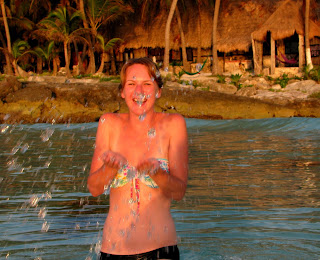I left Sixto in good hands, resting comfortably under a tree at a friend of Rosario’s backyard, I packed a small bag, took a bus to the airport and landed in Havana shortly after. I was fittingly welcomed to Cuba by having to help push start my taxi at the airport, unsure if we were going to rattle along all the way in to the city, however the half hour ride did bring together all those images of Cuba I’d had in my mind – the revolutionary propaganda painted against walls and signed along the highway, the brightly coloured Chevrolet’s from the 50’s, the ox at work in the tropical setting, the deserted highways, the rattling old overcrowded buses and people standing around doing very little, an old man with a cigar, an old women selling fruit on the sidewalk. It’s all there, probably as it has been for a long, long time. Supposedly it’s changing.

To
me it seems Cuba has always held those romantic notions that has kept us
interested from afar: the positive theories of socialism at work; taking sides
with Fidel Castro as David overcoming the might of Goliath or the U.S.; the
idea of drinking rum and salsa dancing in the streets; the feeling of a relaxed
and slow Caribbean island. These curious ideas of Cuba wore off on me as the week went
on.

After
400 years of Spanish
rule then a handful under the U.S. it gained independence at the beginning of
the 20th century. Of the revolution of 1959, Fidel Castro along with
Ernesto Guevara led a guerilla war to successfully overthrow the dictatorship
and soon after withstood a U.S. led invasion at the ‘Bay of Pigs’ and severe
trade embargos. Within a few short years the government was modeled closely to
that of the Soviet Union, even holding Soviet nuclear weapons aimed at the U.S.
in a bitter stand-off for 15 days. The ‘Cuban Missile Crisis’ was one of the
tensest and vulnerable moments of the Cold War. Castro became an inspiration to
revolutionaries and regime changes across the developing world. In the
following decades living standards dropped despite healthcare, education and
housing all provided by the state. Things would get worse with the demise of
the USSR in 1991. Its strong alliance and trade dependence was no longer.

The
subsequent years, ‘the special period’ was very testing for the government with
a major fall in oil and food available which was earlier subsidized from the
Soviets. It encountered a somewhat artificial ‘peak oil crisis’ which is
something the rest of the world can view as an indication of how our lives are
likely to change with the decline of oil production. Some interesting ideas and
necessary steps were taken. Agricultural farmland was divided up to smaller
lots to give more autonomy and increase productivity and agricultural practices
focused on organic methods to improve the quality and longevity of the soils. With
reduced bus services bikes became a necessary mode of transport for all ages,
urban and rooftop gardens popped up all over the cities, household food
rationing coupons ensured people were getting the basic nutritional requirements, hitchhiking and
carpooling systems where implemented. In all, a stronger community spirit was
formed and sharing whatever could be offered was encouraged. Nowadays, a free
market is beginning to open up in certain sectors with private businesses and
licenses offered. Despite this, I can’t see things changing quickly, lack of
opportunities and holding off on progress seems to be what Cubans are used to
and accept. A sense of ambition and improvement to the mundane and contentment
with just the basics will take generations to change. It does feel like a place
stuck back in time where greed and superfluous comforts have no place, just slow and
simple living is the order of the day. I only spent a week here which allowed me a few days in Havana and a few days in the fertile valley of Vinales a few hours away.


I
did a lot of walking in Havana, finding some important landmarks and museums.
It happened to be Carnavale week so I went down to the seaside to watch the
floats and dancers. For every ten blokes that harassed me for money, or asked
for me to buy them a drink or milk for ‘their baby’ or introduce me to
prostitutes I would meet one genuinely friendly Cuban. I met Hector at a local
bar who wanted to show me the streets and speak English and the multi-lingual Omer who I met on the boulevard and who I sat with
for hours playing chess and drinking coffee.
I
took a ride out to Vinales, a small town nestled in a beautiful, red valley
producing much of the rich fruits and vegetables and a leader in tobacco
growing. I took a horse out for an afternoon with a couple of brothers who
showed me around and brought me to Miguel, a tobacco farmer. My highlight of
Cuba was probably sitting with Miguel and his son with a coconut and a cigar watching the
rain drizzle down over the lush and peaceful valley.

These brothers entertained me for an afternoon, repairing the soles of my riding boots, they claimed to have been repaired shoes everyday for the past 25 years. There was plenty of cigar smoking and shots of rum and trying to fathom why and how it was possible to ride a bike around foreign places.









